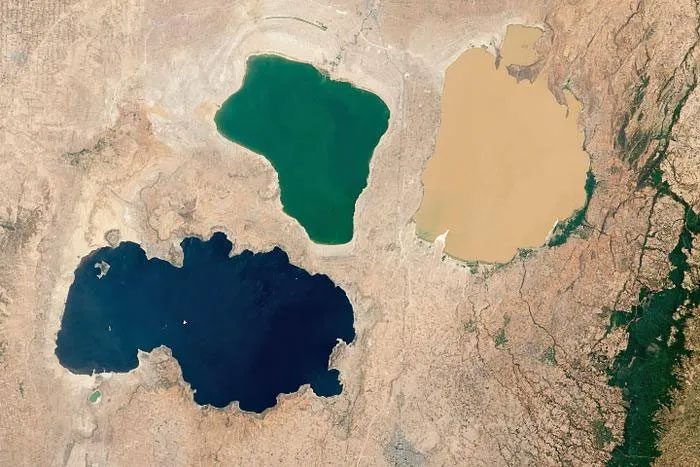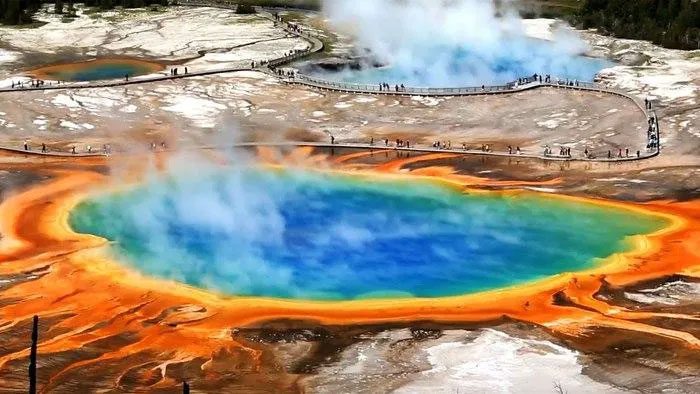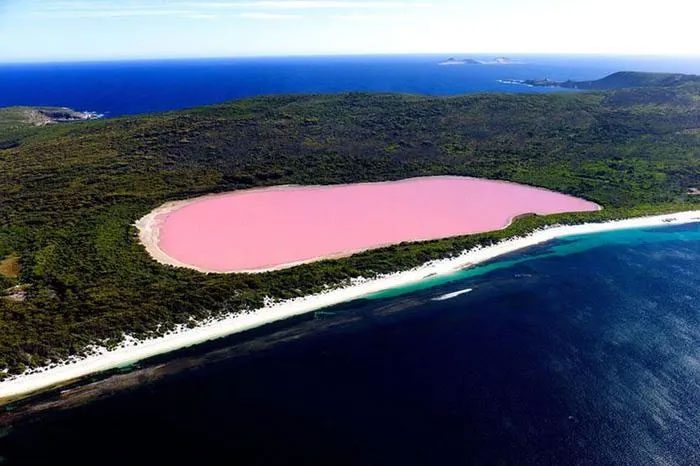The surface waters of lakes on Earth can vary greatly in color, but what causes the rich diversity that creates a “one-of-a-kind” beauty for each body of water?
About 2,000 years ago, three entirely different bodies of water were formed from an ancient Ethiopian lake that was separated. Through tectonic activity and changing rainfall patterns, the vast Galla Lake disappeared, replaced by Lake Shala, Lake Abijata, and Lake Langano—three “brothers” that appear unrelated.
While these three “brothers” share a common origin, lakes in different regions of the world exhibit even more differences.

Once from the same origin, but the 3 lakes have completely different colors. From left to right are Shala, Abijata, and Langano.
Reasons for the Diverse Colors of Lakes Worldwide
So, how do lakes around the world exhibit such different colors?
Several factors contribute to the colorful surfaces seen in various ponds and lakes globally. Minerals are a common cause of water color changes, but lakes can also be influenced by surface runoff, sediments, algae, and sometimes just visual effects.
Surface runoff occurs when the amount of water supplied to the land exceeds its maximum permeability. The water source can be rainwater, melting ice, or other sources flowing into the land. It is part of the land cycle and acts as an agent of erosion.
Over time, water can cause rocks to change, break apart, and dissolve minerals released from the rock surface (“Water flows, rock wears away“). Different colors can result from various minerals found in the rocks surrounding the lake. Color bands ranging from red to green are often produced by iron, magnesium, and calcium carbonate released from limestone.
Among the lakes that were once part of Galla Lake, Lake Abijata receives runoff from the Bulbula River, passing over a lava geological area before depositing soft sediments in its waters. The color of Lake Langano is altered by fine red sediments, creating a murky brown color. Meanwhile, Lake Shala has a deep blue color due to its great depth, with some areas exceeding 260 meters.
However, the diversity seen in these three lakes is considered “milder” compared to the rainbow colors found in other lakes affected by bacteria and algae.

The Grand Prismatic Spring with its vibrant waters.
The Grand Prismatic Spring in Yellowstone National Park is regarded as one of the most famous and beautiful water bodies. The colorful layered effect seen in the outer rings of the hot spring is produced by thermophilic bacteria, while the deep blue center is entirely a result of how we perceive blue light wavelengths.
However, relying on living organisms to maintain vibrant water colors can lead to unpredictability. Lake Retba in Senegal is pink due to a type of beta-carotene produced by algae living in its waters. These organisms produce this pigment as a form of protection against the lake’s harsh saline conditions. But during the rainy season, the water gets diluted and is no longer considered harsh, and the algae stop producing the bright red pigment, causing the lake’s color to change.

Lake Retba in Senegal.
Not only Senegal but Australia is also famous for having many pink lakes, similar to those in Mexico and India. Mainly found in Western and Southern Australia, these are also caused by bacteria and algae thriving in hyper-saline waters, becoming symbols of Australia.
Red carotenoid pigments secreted by Halobacteria and algae known as Dunaliella salina give them their color. While most pink lakes in Australia are seasonally dependent, Lake Hillier in Western Australia remains pink year-round.
Although these vibrant lakes may seem appealing, in some cases, it is best to admire them from a distance. Lake Natron in Tanzania is the most caustic lake in the world, with a pH close to 12, making it extremely dangerous.
Despite its frightening red color, it is not the conditions that cause causticity; rather, it is the presence of a salt-loving microorganism known as Spirulina, which has red, pink, and orange pigments.
The unusual and ever-changing conditions of the Earth’s surface have led to the unique formation of lakes around the world, and as climate change continues, the appearance of these large and iconic bodies of water will also be affected.


















































